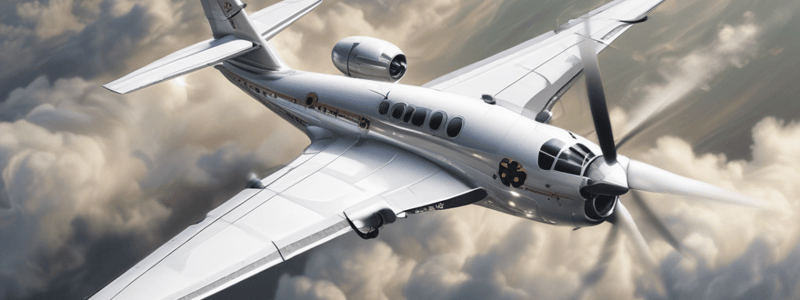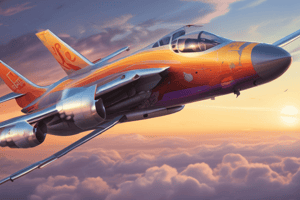Podcast
Questions and Answers
What is the primary role of the center of pressure in an airfoil?
What is the primary role of the center of pressure in an airfoil?
- To control the angle of attack
- To balance the total sum of aerodynamic forces (correct)
- To generate lift
- To reduce drag
What happens to the center of pressure as the angle of attack increases?
What happens to the center of pressure as the angle of attack increases?
- It remains fixed at the midpoint of the chord line
- It disappears
- It moves forward towards the leading edge (correct)
- It moves aft towards the trailing edge
What is the primary consequence of the center of pressure moving too far forward or aft?
What is the primary consequence of the center of pressure moving too far forward or aft?
- Instability (correct)
- Reduced drag
- Increased lift
- Increased stability
What feature is often incorporated into aircraft design to manage the movement of the center of pressure?
What feature is often incorporated into aircraft design to manage the movement of the center of pressure?
What is the primary reason pilots need to be aware of the center of pressure?
What is the primary reason pilots need to be aware of the center of pressure?
What is the primary role of the angle of attack in relation to the center of pressure?
What is the primary role of the angle of attack in relation to the center of pressure?
What is the consequence of a forward shift of the center of pressure at high angles of attack?
What is the consequence of a forward shift of the center of pressure at high angles of attack?
What is the primary reason engineers need to understand the behavior of the center of pressure?
What is the primary reason engineers need to understand the behavior of the center of pressure?
What is the relationship between the angle of attack and the center of pressure?
What is the relationship between the angle of attack and the center of pressure?
What is the primary benefit of understanding the behavior of the center of pressure?
What is the primary benefit of understanding the behavior of the center of pressure?
The center of pressure is a fixed point along the chord line of an airfoil.
The center of pressure is a fixed point along the chord line of an airfoil.
A decrease in the angle of attack causes the center of pressure to move forward towards the leading edge of the airfoil.
A decrease in the angle of attack causes the center of pressure to move forward towards the leading edge of the airfoil.
The center of pressure is the point where the total sum of aerodynamic forces is zero.
The center of pressure is the point where the total sum of aerodynamic forces is zero.
The movement of the center of pressure has no effect on the stability of the aircraft.
The movement of the center of pressure has no effect on the stability of the aircraft.
The center of pressure is only important for pilots and not for engineers.
The center of pressure is only important for pilots and not for engineers.
The angle of attack has no effect on the position of the center of pressure.
The angle of attack has no effect on the position of the center of pressure.
The center of pressure is only relevant during certain flight conditions.
The center of pressure is only relevant during certain flight conditions.
A rearward shift of the center of pressure can lead to a decrease in the tendency of an aircraft to pitch nose-up.
A rearward shift of the center of pressure can lead to a decrease in the tendency of an aircraft to pitch nose-up.
The center of pressure is always located at the midpoint of the chord line.
The center of pressure is always located at the midpoint of the chord line.
The aerodynamic forces acting on an airfoil are always balanced at the center of pressure.
The aerodynamic forces acting on an airfoil are always balanced at the center of pressure.
What analogy is used to describe the function of the center of pressure in an airfoil?
What analogy is used to describe the function of the center of pressure in an airfoil?
What is the effect of an increase in angle of attack on the position of the center of pressure?
What is the effect of an increase in angle of attack on the position of the center of pressure?
Why is it essential for engineers to understand the behavior of the center of pressure?
Why is it essential for engineers to understand the behavior of the center of pressure?
What is the potential consequence of the center of pressure moving too far forward or aft?
What is the potential consequence of the center of pressure moving too far forward or aft?
How do designers manage the movement of the center of pressure?
How do designers manage the movement of the center of pressure?
What is the significance of the center of pressure in relation to aerodynamic balance?
What is the significance of the center of pressure in relation to aerodynamic balance?
Why is it important for pilots to be aware of the changes in aerodynamic forces during maneuvers?
Why is it important for pilots to be aware of the changes in aerodynamic forces during maneuvers?
What happens to the center of pressure as the angle of attack decreases?
What happens to the center of pressure as the angle of attack decreases?
What is the primary benefit of understanding the behavior of the center of pressure for pilots and engineers?
What is the primary benefit of understanding the behavior of the center of pressure for pilots and engineers?
Why is the center of pressure not a fixed point along the chord line of an airfoil?
Why is the center of pressure not a fixed point along the chord line of an airfoil?
Flashcards are hidden until you start studying
Study Notes
Module 3: Aircraft Performance and Design
- Introduced to the critical concept of center of pressure (CP) in aircraft design and flight, ensuring balance and stability.
Center of Pressure (CP)
- Defined as the point along the chord line of an airfoil at which all aerodynamic forces are considered to act.
- The focal point of aerodynamic forces, determining how they are distributed across the aircraft's wing.
- Crucial for balance and stability, affecting the aircraft's pitch behavior.
Aerodynamic Forces and CP
- Lift is generated perpendicular to the plane's wings, while drag pulls back against the aircraft's motion.
- The intersection of these forces occurs at the CP, deciding the magnitude and distribution of lift across the wing.
Angle of Attack (AoA) and CP
- AoA is the angle between the oncoming air or relative wind and a reference line on the airfoil.
- Increasing AoA causes the CP to move forward, while decreasing AoA causes the CP to move aft.
- Shifts in CP affect the aircraft's performance, stability, and control.
Importance of CP in Flight
- Understanding CP is essential for pilots to navigate the skies adeptly and for aircraft designers to ensure efficient flight.
- Mastering CP is crucial for safe flight, as it affects aerodynamic balance, stability, and control.
Shifts in CP
- CP shifts forward or aft in response to changes in AoA, impacting the aircraft's performance and stability.
- Shifts in CP can lead to nose-heavy or tail-heavy aircraft, affecting stability and control.
Airfoil Design and CP
- Engineers must anticipate shifts in CP at all operational angles of attack to ensure stable flight.
- Airfoil design must consider CP to maintain control and stability throughout various phases of flight.
Conclusion
- Understanding the interplay between AoA, lift, and CP is essential for determining an aircraft's readiness to contend with aerodynamic forces.
- Aerodynamic balance, stability, and control are crucial concepts in aircraft design and flight, with CP at their heart.
Module 3: Aircraft Performance and Design
- Introduced to the critical concept of center of pressure (CP) in aircraft design and flight, ensuring balance and stability.
Center of Pressure (CP)
- Defined as the point along the chord line of an airfoil at which all aerodynamic forces are considered to act.
- The focal point of aerodynamic forces, determining how they are distributed across the aircraft's wing.
- Crucial for balance and stability, affecting the aircraft's pitch behavior.
Aerodynamic Forces and CP
- Lift is generated perpendicular to the plane's wings, while drag pulls back against the aircraft's motion.
- The intersection of these forces occurs at the CP, deciding the magnitude and distribution of lift across the wing.
Angle of Attack (AoA) and CP
- AoA is the angle between the oncoming air or relative wind and a reference line on the airfoil.
- Increasing AoA causes the CP to move forward, while decreasing AoA causes the CP to move aft.
- Shifts in CP affect the aircraft's performance, stability, and control.
Importance of CP in Flight
- Understanding CP is essential for pilots to navigate the skies adeptly and for aircraft designers to ensure efficient flight.
- Mastering CP is crucial for safe flight, as it affects aerodynamic balance, stability, and control.
Shifts in CP
- CP shifts forward or aft in response to changes in AoA, impacting the aircraft's performance and stability.
- Shifts in CP can lead to nose-heavy or tail-heavy aircraft, affecting stability and control.
Airfoil Design and CP
- Engineers must anticipate shifts in CP at all operational angles of attack to ensure stable flight.
- Airfoil design must consider CP to maintain control and stability throughout various phases of flight.
Conclusion
- Understanding the interplay between AoA, lift, and CP is essential for determining an aircraft's readiness to contend with aerodynamic forces.
- Aerodynamic balance, stability, and control are crucial concepts in aircraft design and flight, with CP at their heart.
Module 3: Aircraft Performance and Design
- Introduced to the critical concept of center of pressure (CP) in aircraft design and flight, ensuring balance and stability.
Center of Pressure (CP)
- Defined as the point along the chord line of an airfoil at which all aerodynamic forces are considered to act.
- The focal point of aerodynamic forces, determining how they are distributed across the aircraft's wing.
- Crucial for balance and stability, affecting the aircraft's pitch behavior.
Aerodynamic Forces and CP
- Lift is generated perpendicular to the plane's wings, while drag pulls back against the aircraft's motion.
- The intersection of these forces occurs at the CP, deciding the magnitude and distribution of lift across the wing.
Angle of Attack (AoA) and CP
- AoA is the angle between the oncoming air or relative wind and a reference line on the airfoil.
- Increasing AoA causes the CP to move forward, while decreasing AoA causes the CP to move aft.
- Shifts in CP affect the aircraft's performance, stability, and control.
Importance of CP in Flight
- Understanding CP is essential for pilots to navigate the skies adeptly and for aircraft designers to ensure efficient flight.
- Mastering CP is crucial for safe flight, as it affects aerodynamic balance, stability, and control.
Shifts in CP
- CP shifts forward or aft in response to changes in AoA, impacting the aircraft's performance and stability.
- Shifts in CP can lead to nose-heavy or tail-heavy aircraft, affecting stability and control.
Airfoil Design and CP
- Engineers must anticipate shifts in CP at all operational angles of attack to ensure stable flight.
- Airfoil design must consider CP to maintain control and stability throughout various phases of flight.
Conclusion
- Understanding the interplay between AoA, lift, and CP is essential for determining an aircraft's readiness to contend with aerodynamic forces.
- Aerodynamic balance, stability, and control are crucial concepts in aircraft design and flight, with CP at their heart.
Studying That Suits You
Use AI to generate personalized quizzes and flashcards to suit your learning preferences.





